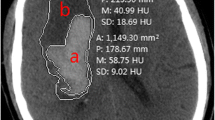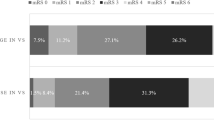Abstract
Background
Recent reports suggest that when thrombolytic agents are administered within the clot, lysis rate accelerates at the expense of increased risk of worsening edema. To test this hypothesis, we report on the volumetric analysis of (1) the intraparenchymal hematoma and, (2) perihematomal edema in a cohort of ICH patients treated with intraclot rtPA.
Methods
A convenience sample of highly selected ICH patients underwent frameless stereotactic aspiration and thrombolysis (FAST) of the clot. Two milligrams of rtPA were administered every 12 h until ICH volume ≤10 cc, or catheter fenestrations were no longer in continuity with the clot. ICH and perihematomal edema volumes were calculated from CT scans. Using random effects linear regression we estimated the rate of hematoma and edema volume resolution as well as their relationship during the first 8 days of lytic therapy.
Results
Fifteen patients were treated, mean age: 60.7 years, median time from ictus to FAST: 1 (range 0–3) day. Using a random effects model that considered volume resolution over the first 8 days following lytic therapy we found that the both percentage hematoma and percentage perihematoma edema resolution per day were quadratic with respect to time. Percentage residual hematoma volume on day K = 97.7% − [24.36%*K] + [1.89%*K 2]; P < 0.001 for both terms. Percentage residual edema on day K = 97.4% − [13.94%*K] + [1.30%*K 2]; P < 0.001 for K and P = 0.01 for K 2. Examination of each patient’s volume data suggests that there exists a strong direct relationship between perihematoma edema volume and same day hematoma volume.
Conclusions
In this cohort of ICH patients treated using FAST, volumetric analysis of ICH and perihematomal edema seems to suggest that local use of rtPA does not exacerbate brain edema formation. Furthermore, there seems to be a strong association between reduction in ICH volume and reduction in edema volume, as would be expected following the concept of “hemotoxicity” postulated by some investigators.



Similar content being viewed by others
References
Zazulia AR, Diringer MN, Derdeyn CP, Powers WJ. Progression of mass effect after intracerebral hemorrhage. Stroke 1999;30:1167–73.
Xi G, Keep RF, Hoff JT. Mechanisms of brain injury after intracerebral haemorrhage. Lancet Neurol. 2006;5:53–63.
Wagner KR, Xi G, Hua Y, Zuccarello M, de Courten-Myers GM, Broderick JP, Brott TG. Ultra-early clot aspiration after lysis with tissue plasminogen activator in a porcine model of intracerebral hemorrhage: edema reduction and blood–brain barrier protection. J Neurosurg. 1999;90:491–8.
Okuda M, Suzuki R, Moriya M, Fujimoto M, Chang CW, Fujimoto T. The effect of hematoma removal for reducing the development of brain edema in cases of putaminal hemorrhage. Acta Neurochir Suppl. 2006;96:74–7.
Mayer SA, Brun NC, Begtrup K, Broderick J, Davis S, Diringer MN, Skolnick BE, Steiner T. Recombinant activated factor vii for acute intracerebral hemorrhage. N Engl J Med. 2005;352:777–85.
Lapointe M, Haines S. Fibrinolytic therapy for intraventricular hemorrhage in adults. Cochrane Database Syst Rev. 2002;CD003692.
Figueroa BE, Keep RF, Betz AL, Hoff JT. Plasminogen activators potentiate thrombin-induced brain injury. Stroke 1998;29:1202–1207; discussion 1208.
Rohde V, Rohde I, Thiex R, Ince A, Jung A, Duckers G, Groschel K, Rottger C, Kuker W, Muller HD, Gilsbach JM. Fibrinolysis therapy achieved with tissue plasminogen activator and aspiration of the liquefied clot after experimental intracerebral hemorrhage: rapid reduction in hematoma volume but intensification of delayed edema formation. J Neurosurg. 2002;97:954–62.
Yepes M, Sandkvist M, Moore EG, Bugge TH, Strickland DK, Lawrence DA. Tissue-type plasminogen activator induces opening of the blood–brain barrier via the ldl receptor-related protein. J Clin Invest. 2003;112:1533–40.
Barrett RJ, Hussain R, Coplin WM, Berry S, Keyl PM, Hanley DF, Johnson RR, Carhuapoma JR. Frameless stereotactic aspiration and thrombolysis of spontaneous intracerebral hemorrhage. Neurocrit Care. 2005;3:237–45.
Mendelow AD, Gregson BA, Fernandes HM, Murray GD, Teasdale GM, Hope DT, Karimi A, Shaw MD, Barer DH. Early surgery versus initial conservative treatment in patients with spontaneous supratentorial intracerebral haematomas in the international surgical trial in intracerebral haemorrhage (stich): a randomised trial. Lancet 2005;365:387–97.
Tuhrim S, Horowitz DR, Sacher M, Godbold JH. Volume of ventricular blood is an important determinant of outcome in supratentorial intracerebral hemorrhage. Crit Care Med. 1999;27:617–21.
Tuhrim S, Dambrosia JM, Price TR, Mohr JP, Wolf PA, Hier DB, Kase CS. Intracerebral hemorrhage: external validation and extension of a model for prediction of 30-day survival. Ann Neurol. 1991;29:658–63.
Broderick JP, Brott TG, Duldner JE, Tomsick T, Huster G. Volume of intracerebral hemorrhage. A powerful and easy-to-use predictor of 30-day mortality. Stroke 1993;24:987–93.
Schaller C, Rohde V, Meyer B, Hassler W. Stereotactic puncture and lysis of spontaneous intracerebral hemorrhage using recombinant tissue-plasminogen activator. Neurosurgery 1995;36:328–33; discussion 333–325.
Deinsberger W, Lang C, Hornig C, Boeker DK. Stereotactic aspiration and fibrinolysis of spontaneous supratentorial intracerebral hematomas versus conservative treatment: a matched-pair study. Zentralbl Neurochir. 2003;64:145–50.
Naff NJ, Carhuapoma JR, Williams MA, Bhardwaj A, Ulatowski JA, Bederson J, Bullock R, Schmutzhard E, Pfausler B, Keyl PM, Tuhrim S, Hanley DF. Treatment of intraventricular hemorrhage with urokinase: effects on 30-day survival. Stroke 2000;31:841–7.
Broderick JP, Adams HP Jr., Barsan W, Feinberg W, Feldmann E, Grotta J, Kase C, Krieger D, Mayberg M, Tilley B, Zabramski JM, Zuccarello M. Guidelines for the management of spontaneous intracerebral hemorrhage: a statement for healthcare professionals from a special writing group of the stroke council, American heart association. Stroke 1999;30:905–15.
Naff NJ, Williams MA, Rigamonti D, Keyl PM, Hanley DF. Blood clot resolution in human cerebrospinal fluid: evidence of first-order kinetics. Neurosurgery 2001;49:614–9; discussion 619–621.
Zimmerman RD, Maldjian JA, Brun NC, Horvath B, Skolnick BE. Radiologic estimation of hematoma volume in intracerebral hemorrhage trial by ct scan. AJNR Am J Neuroradiol. 2006;27:666–70.
Zuccarello M, Andaluz N, Wagner KR. Minimally invasive therapy for intracerebral hematomas. Neurosurg Clin N Am. 2002;13:349–54.
Zuccarello M, Andrioli GG, Trincia G, Pardatscher K. Spontaneous intracerebral haematomas. Aspects of treatment. Zentralbl Neurochir. 1983;44:209–13.
Lippitz BE, Mayfrank L, Spetzger U, Warnke JP, Bertalanffy H, Gilsbach JM. Lysis of basal ganglia haematoma with recombinant tissue plasminogen activator (rtpa) after stereotactic aspiration: initial results. Acta Neurochir (Wien) 1994;127:157–60.
Matsumoto K, Hondo H. Ct-guided stereotaxic evacuation of hypertensive intracerebral hematomas. J Neurosurg. 1984;61:440–8.
Miller DW, Barnett GH, Kormos DW, Steiner CP. Stereotactically guided thrombolysis of deep cerebral hemorrhage: preliminary results. Cleve Clin J Med. 1993;60:321–4.
Mohadjer M, Braus DF, Myers A, Scheremet R, Krauss JK. Ct-stereotactic fibrinolysis of spontaneous intracerebral hematomas. Neurosurg Rev. 1992;15:105–10.
Montes JM, Wong JH, Fayad PB, Awad IA. Stereotactic computed tomographic-guided aspiration and thrombolysis of intracerebral hematoma: protocol and preliminary experience. Stroke 2000;31:834–40.
Niizuma H, Otsuki T, Johkura H, Nakazato N, Suzuki J. Ct-guided stereotactic aspiration of intracerebral hematoma—result of a hematoma-lysis method using urokinase. Appl Neurophysiol. 1985;48:427–30.
Rohde V, Rohde I, Reinges MH, Mayfrank L, Gilsbach JM. Frameless stereotactically guided catheter placement and fibrinolytic therapy for spontaneous intracerebral hematomas: technical aspects and initial clinical results. Minim Invasive Neurosurg. 2000;43:9–17.
Tzaan WC, Lee ST, Lui TN. Combined use of stereotactic aspiration and intracerebral streptokinase infusion in the surgical treatment of hypertensive intracerebral hemorrhage. J Formos Med Assoc. 1997;96:962–7.
Vespa P, McArthur D, Miller C, O’Phelan K, Frazee J, Kidwell C, Saver J, Starkman S, Martin N. Frameless stereotactic aspiration and thrombolysis of deep intracerebral hemorrhage is associated with reduction of hemorrhage volume and neurological improvement. Neurocrit Care 2005;2:274–81.
Wang YF, Tsirka SE, Strickland S, Stieg PE, Soriano SG, Lipton SA. Tissue plasminogen activator (tpa) increases neuronal damage after focal cerebral ischemia in wild-type and tpa-deficient mice. Nat Med. 1998;4:228–31.
Thiex R, Kuker W, Jungbluth P, Kayser C, Muller HD, Rohde I, Gilsbach JM, Rohde V. Minor inflammation after surgical evacuation compared with fibrinolytic therapy of experimental intracerebral hemorrhages. Neurol Res. 2005;27:493–8.
Thiex R, Kuker W, Muller HD, Rohde I, Schroder JM, Gilsbach JM, Rohde V. The long-term effect of recombinant tissue-plasminogen-activator (rt-pa) on edema formation in a large-animal model of intracerebral hemorrhage. Neurol Res. 2003;25:254–62.
Acknowledgment
Dr. Daniel F. Hanley is partially supported by NIH NINDS 1R01 NS046309-01.
Author information
Authors and Affiliations
Corresponding author
Rights and permissions
About this article
Cite this article
Carhuapoma, J.R., Barrett, R.J., Keyl, P.M. et al. Stereotactic Aspiration-Thrombolysis of Intracerebral Hemorrhage and its Impact on Perihematoma Brain Edema. Neurocrit Care 8, 322–329 (2008). https://doi.org/10.1007/s12028-008-9074-y
Published:
Issue Date:
DOI: https://doi.org/10.1007/s12028-008-9074-y




